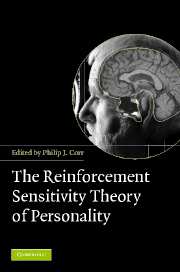Book contents
- Frontmatter
- Contents
- List of abbreviations
- List of figures
- List of tables
- List of contributors
- Preface
- 1 Reinforcement Sensitivity Theory (RST): introduction
- 2 The neuropsychology of fear and anxiety: a foundation for Reinforcement Sensitivity Theory
- 3 Animal cognition and human personality
- 4 The behavioural activation system: challenges and opportunities
- 5 Reinforcement Sensitivity Theory and personality
- 6 Reinforcement sensitivity scales
- 7 Performance and conditioning studies
- 8 Psychophysiological studies
- 9 Reinforcement Sensitivity Theory and mood induction studies
- 10 Neuro-imaging and genetics
- 11 Reinforcement Sensitivity Theory and psychosomatic medicine
- 12 RST and clinical disorders: anxiety and depression
- 13 RST and psychopathy: associations between psychopathy and the behavioral activation and inhibition systems
- 14 Behavioural activation and inhibition in social adjustment
- 15 Reinforcement sensitivity in the workplace: BIS/BAS in business
- 16 Formal and computational models of Reinforcement Sensitivity Theory
- 17 Reinforcement Sensitivity Theory: a critique from cognitive science
- 18 The contribution of Reinforcement Sensitivity Theory to personality theory
- General Index
- Index of Names
- References
3 - Animal cognition and human personality
Published online by Cambridge University Press: 31 January 2011
- Frontmatter
- Contents
- List of abbreviations
- List of figures
- List of tables
- List of contributors
- Preface
- 1 Reinforcement Sensitivity Theory (RST): introduction
- 2 The neuropsychology of fear and anxiety: a foundation for Reinforcement Sensitivity Theory
- 3 Animal cognition and human personality
- 4 The behavioural activation system: challenges and opportunities
- 5 Reinforcement Sensitivity Theory and personality
- 6 Reinforcement sensitivity scales
- 7 Performance and conditioning studies
- 8 Psychophysiological studies
- 9 Reinforcement Sensitivity Theory and mood induction studies
- 10 Neuro-imaging and genetics
- 11 Reinforcement Sensitivity Theory and psychosomatic medicine
- 12 RST and clinical disorders: anxiety and depression
- 13 RST and psychopathy: associations between psychopathy and the behavioral activation and inhibition systems
- 14 Behavioural activation and inhibition in social adjustment
- 15 Reinforcement sensitivity in the workplace: BIS/BAS in business
- 16 Formal and computational models of Reinforcement Sensitivity Theory
- 17 Reinforcement Sensitivity Theory: a critique from cognitive science
- 18 The contribution of Reinforcement Sensitivity Theory to personality theory
- General Index
- Index of Names
- References
Summary
Reinforcement Sensitivity Theory (RST) is based, both in terms of data and concepts, on the experimental analysis of (non-human) animal behaviour. Some workers in emotion and human personality research question its validity on this count alone. But, since Galileo and Copernicus, our world has clearly not been the centre of the wider universe. Likewise, since Darwin, biology has accepted the essential continuity between our own and other species (with chimpanzees, genetically speaking, being 98 per cent human), where the human form and characters have not been the goal of evolution. In this chapter we evaluate the claim that emotion and personality, nonetheless, remain distinct from the rest of biology; that with them it is still the case that ‘the only proper study of mankind is man’. This will clarify the foundations on which RST rests.
Emotion and personality can be approached from more ‘cognitive’ (e.g., Matthews, chapter 17) or ‘biological’ (McNaughton and Corr, chapter 1) perspectives. But these are really different sides of the same coin. There are cases where cognitive or biological factors may seem relatively more important. But both kinds of case exist. This requires a true theoretical and empirical integration to take a combined ‘biocognitive’ perspective. Each approach fills the gaps left by the other. Their combination leads to a richer picture and a deeper understanding.
- Type
- Chapter
- Information
- The Reinforcement Sensitivity Theory of Personality , pp. 95 - 119Publisher: Cambridge University PressPrint publication year: 2008
References
- 4
- Cited by



